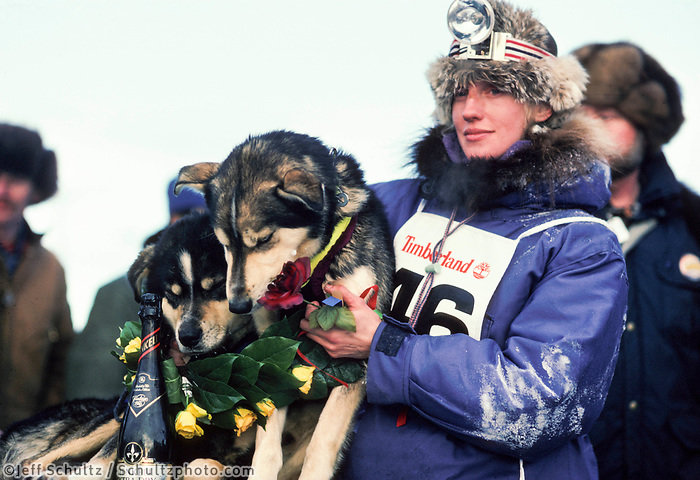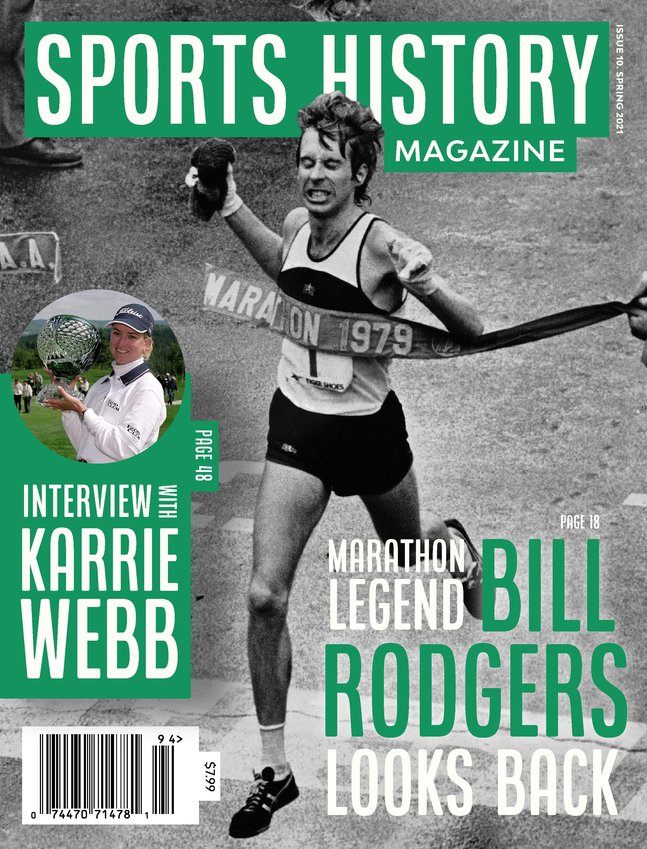Libby Riddles, 1st Female Champ of the Iditarod
Mushing 1,000 miles across the frozen Alaskan wilderness
In 1985, Libby Riddles became the first woman to conquer the Iditarod Trail Sled Dog Race, the world’s most prestigious canine mushing competition.
Braving harsh winter conditions including a vicious arctic storm, the 29-year old finished the 1,000-mile chase across the Alaskan wilderness in 18 days and 20 minutes, hours ahead of all her male counterparts.
Libby became an instant celebrity and an inspiration for women around the world, proving they can hold their own, plus a lot more, in the toughest of all sporting challenges.
Libby went on to write three books, including Race Across Alaska, her personal story at the Iditarod, and two other children’s books. In 2007, she was also inducted into the Alaska Sports Hall of Fame.
Sports History Magazine asked Libby to share her thoughts about the famed race and being the first female champion in one of the most grueling sporting events on the planet.
How did you first become interested in dog sledding?
I always wanted a life with animals and they seemed the most practical for Alaska.
How does a person train for a long-distance dog sled race?
It's very obsessive. Many hours spent training, preparing, and caring for the dogs. A lot of experimentation, trying to come up with better ways to do things and improve gear for dogs and musher.
How do you build a winning dog team?
Lots of dedication, time spent together gaining experience racing, or using them for travel and for work like getting firewood and ice fishing. Basically, giving them experiences they will need to be prepared and building mutual trust between musher and team. Good luck helps too!
The Iditarod Trail Sled Dog Race is over 1,000 miles long and is contested over many days and nights. Did you have a strategy when out in the wilderness?
My strategy has always been to do the best my team and I can do. We have a basic schedule, but things happen and you have to know when to adjust according to conditions and how your team is doing. You have to know when to take a chance, too.
The first Iditarod took place in 1973 and was won in 20 days. Today, winners clear the finish line in 9 days. What makes it so much faster now?
Competition has made for some truly amazing endurance huskies. Training and diet has improved over time and I think global warming has made for easier trail and conditions in some years.
The race is so brutal that competitors become sleep deprived and even start hallucinating on the trail. How do you cope with such fatigue?
Real mushers don't whine. You go into it knowing everyone else is facing the same thing. If you can cope with it stronger, maybe you win.
What are the biggest challenges in the race for the dogs?
The possibility of picking up viruses from teams that come from all over to join in the race. It's such a disappointment to get a bug in the team. We try to build their immune system and it is part of the training to go to earlier races of shorter distance for practice and exposure to the current season’s viruses.
If the musher prepares the dogs well and cares for them well along the trail, the dogs that are meant to do this kind of thing can often be ready to turn around and do it again with a couple days off at the finish. For the ones that it's hard, they find themselves doing tours instead of racing!
In 1985, you became the first woman to win the Iditarod. What do you attribute that remarkable feat to?
Focus, a good team of human and canine, being lucky enough to know what I wanted at a young age and going for it.
That year, conditions were also especially harsh due to severe storms. Were there moments when you actually feared for your life?
Not really, because in the heart of it I was too busy to waste energy being afraid.
After you, Susan Butcher became the second woman to claim the Iditarod and she won it 3 years in a row. So, men don't have a natural biological advantage over women in this particular challenge?
Dog mushing has maybe the most diverse group of competitors of any sport because you need many different types of skills to be good at it. Women are good at endurance and mental toughness, especially us northern gals!
The Iditarod trail had to be redrawn at least twice due to lack of snow. Do you sense that climate change is threatening the race?
It has made it tough for the sport and for people to train. In Alaska and other northern places, we see the change much more radically than some places.
Even though we're having a cold snap now, we've just had the warmest year on record. It's depressing to have no snow until midwinter.
You authored a few books about your experience at the Iditarod. Tell us about them?
I started keeping journals as a teenager and it led me to write about the Iditarod after winning. I wrote Race Across Alaska with journalist Tim Jones. It was on the American Library Association list of top twenty books for young adults, and was also runner-up to a dog writers award.
I also made my living selling the books to cruise ship passengers in SE Alaska. I wrote a kids’ version of the story called Storm Run because so many schools, teachers and kids love the Iditarod, and girls need stories like this!
I wrote Danger the Dog Yard Cat with my friend and Iditarod finisher, Shelley Gill, for younger kids because I like cats, too.
ENJOY OUR CONTENT? SIGN UP FOR OUR FREE WEEKLY NEWSLETTER AND SHARE ON YOUR SOCIAL MEDIA










